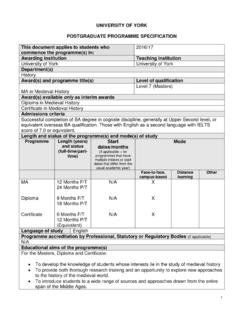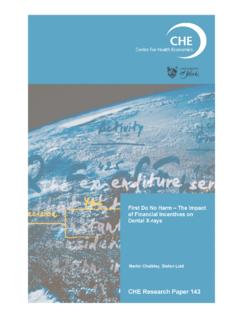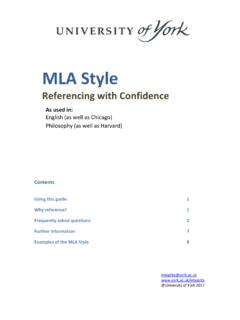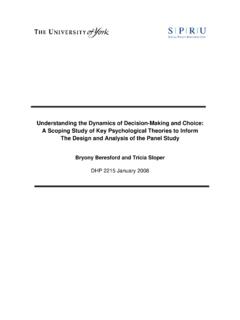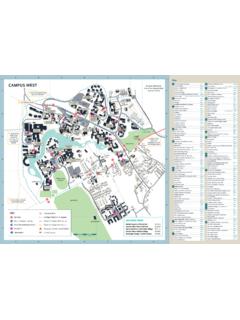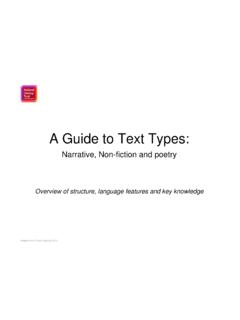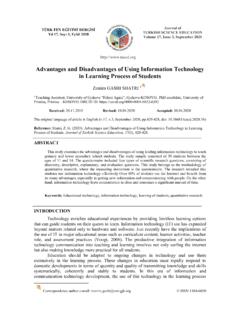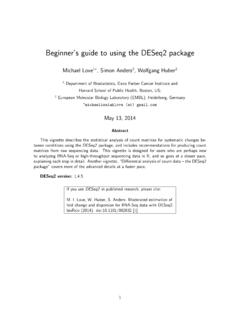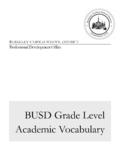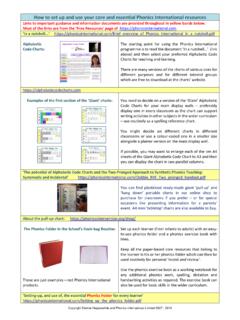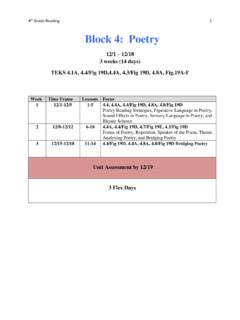Transcription of Using Diagnostic Assessment to Enhance Teaching and …
1 Evidence-based Practice in Science Education (EPSE) Research Network Using Diagnostic Assessment to Enhance Teaching and Learning A Study of the Impact of Research-informed Teaching Materials on Science Teachers Practices Robin Millar and Vicky Hames September 2003 Acknowledgements The research project discussed in this report was one of four inter-related projects, exploring the relationship between research and practice in science education, undertaken by the Evidence-based Practice in Science Education (EPSE) Research Network, a collaboration involving the Universities of York, Leeds, Southampton and King s College London. The EPSE Network was funded by the UK Economic and Social Research Council (ESRC) in Phase 1 of the Teaching and Learning Research Programme (TLRP) (grant no. L139 25 1003). We acknowledge the contribution of our EPSE colleagues, John Leach, Jonathan Osborne, Mary Ratcliffe, Hannah Bartholomew, Andy Hind and Jaume Ametller to our thinking about the issues involved in this work.
2 1 1 Aim and rationale The central issue which the project discussed in this report set out to explore is the relationship between research and practice in science education more specifically, the relationship between research on the learning of scientific ideas on the one hand, and teachers actions and choices in the classroom on the other. Over the past 30 years, a great deal of research has been carried out in many countries on learners ideas about the natural world. This has helped identify commonly-held ideas which differ from the accepted scientific view, and has shown that these are often very resistant to change (see, for example, Driver et al., 1994; Pfundt & Duit, 1994). These findings have clear implications for the pace and sequence of instruction in many science topics, particularly those which involve understanding of fundamental ideas and models. Yet whilst many teachers know of this research, it has had little systematic impact on classroom practices, or on science education policy, in the UK.
3 The aim of this project was to explore a possible way of enhancing the impact on teachers practices of the insights and findings of research on science learning. 2 Context and background Some critiques of educational research have attributed its lack of impact on practice, at least in part, to poor communication between researchers and practitioners (for example, Hillage et al., 1998). In response, some have suggested that researchers need to write up their findings in briefer and more accessible formats, such as short research briefings, which communicate the principal findings of their work clearly and quickly to busy users . Effective communication may, however, involve rather more than this. The steps of identifying the practical implications of research findings, devising materials and approaches to implement them, and testing these in use are far from trivial. Compared to the large body of research on students ideas in science, rather less research has focused on testing possible ways of improving students learning of these difficult ideas.
4 Implications identified in the concluding sections of research articles, and the suggestions for action proposed, are usually based on professional experience, rather than on research evidence that the suggested approach will achieve better outcomes than the current one. In fact, as Lijnse (2000) points out, science education research offers little direct or specific guidance to teachers about how best to teach specific topics to specific groups of learners. There are, of course, some examples of Teaching sequences and programmes for school science topics that have been developed by researchers in the light of their findings (and those of others) (for example, CLISP (Children s Learning in Science Project), 1987; Klaassen, 1995; Viennot and Rainson, 1999; Tiberghien, 2000). Viennot (2001: 36-43) discusses an example of research influencing the detail of a national curriculum specification.
5 All of these examples involve a transformation of knowledge from the form of a research finding (a summary statement grounded in empirical evidence) into Teaching materials or guidelines that can be implemented in the classroom. 2 In this project, we have also chosen the approach of providing teachers with materials that they can use directly. Rather than attempt to communicate research findings to teachers, or to develop with them Teaching sequences based on research findings, we have produced, and made available to teachers, a collection of instruments and tools of the kind used by researchers to collect evidence of students learning. These Diagnostic questions make it easier for teachers to collect data on the progress of their own classes. Their practice is then more evidence-informed in the sense that they can base decisions about the pace and sequence of instruction on better evidence of their students current ideas and understandings.
6 It is also evidence-informed in the sense that the questions themselves embody insights, and reflect outcomes, of a body of previous research, by focusing attention on key points and issues that have been shown by research to be important for learning. One influence on the choice of this approach was the evidence of significant impact, on university-level physics Teaching in the USA, of the Force Concept Inventory (Hestenes et al., 1990) and several other similar inventories that have appeared in the past decade. These provide a quick means of surveying the understanding of students. Their existence has stimulated many teachers to modify their Teaching methods and approaches, in response to what they perceived as unsatisfactory performance by their own students (Mazur, 1997; Redish, 2003) leading in some cases to measured gains in performance as a result of the changes introduced.
7 One aim of the project reported in this paper is to work towards similar instruments for use at school level. A second influence was the major research review by Black and Wiliam (1998a, b) showing that the use by teachers of formative Assessment can lead to significant learning gains by their students. One barrier to the wider use of such approaches may be the shortage of suitable questions and tasks for formative Assessment . If so, providing materials may be significant in increasing uptake of an approach which research has shown to work . This, then, is a third sense in which the Teaching methods which this project is aiming to promote are evidence-informed. 3 Overview of the project In outline, then, the strategy in this project was to develop banks of Diagnostic questions that teachers could use when Teaching some important science topics, to give these to a sample of teachers, and monitor with them how they used them in their Teaching .
8 The three topics chosen were: electric circuits, forces and motion, and particle models of matter. This choice was made in collaboration with a partnership group of teachers, researchers and other science education practitioners (Local Education Authority science advisors, textbook authors, examiners) who contributed throughout the project to its design and implementation. These topics met the following selection criteria: they are central to the Science National Curriculum for England (DfEE/QCA,1999); they are topics for which it was felt many teachers would welcome additional Teaching resources and ideas; they involve understanding models and explanations, rather than recall of facts; there is a substantial body of research on student 3 learning in these topics, which provides a starting point for developing a Diagnostic question bank. To develop Diagnostic question banks, we first reviewed the published literature in these topic areas to collect together as many as possible of the instruments and tools used by researchers to probe pupils understandings (for example, APU, 1988-9; Shipstone et al.)
9 , 1988; Hestenes et al., 1990). Where there were gaps, new questions were devised. On the advice of the teachers in the group, all were designed to be relatively quick to use, to facilitate their use in formative Assessment , where quick interpretation of a class s responses is essential. For this reason, many of the items in the banks are closed format, such as single-tier and two-tier multiple choice questions (Haslam and Treagust, 1987; Treagust, 1988), though many also have open-response sections. Whilst all could be used as individual written tasks, some are intended as stimuli for group discussion activities or even for predict-observe-explain practical tasks (White and Gunstone, 1992). Draft questions were first reviewed by teachers in the Partnership Group (and some others) to check their face validity, to improve them where necessary and make them more usable in classrooms. Sets of questions were then piloted in these teachers schools by class sets of around 30 pupils.
10 We also interviewed a sample of these pupils to explore the reasoning behind their answers. We also trailed some open-response questions to help devise answer options for structured-response versions. Checks on consistency of response to several items testing the same science idea, or to the same question on two different occasions, were also carried out. This resulted in large banks of Diagnostic questions, eventually consisting of over 200 items each for electric circuit and forces and motion, and over 100 on matter and the particle model1. Teachers in a sample of 10 schools (8 secondary; 2 primary), were then given the complete item bank on one science topic, with some outline suggestions on possible ways of Using these. No training was provided as we did not want to influence the use of the materials too strongly. Four of these teachers had been involved in developing the banks; others had heard about the project and expressed an interest in being involved in it.
